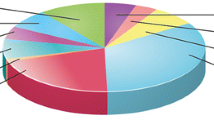Abstract
The U.S. Navy’s certification and qualification process for materials and structures is undertaken to ensure the flight safety and full mission capability of naval aviation weapon systems. A building-block process is practiced in which validated engineering data and concepts provide the foundation for continued technological development and innovation. For example, prior to developing material-property standards, the manufacturing process is frozen and fully characterized. The customer’s cost, schedule, and performance requirements must be carefully considered. Technologies are selected for immediate use or further R&D based upon a risk assessment that takes into account many factors, including technological maturity, lessons learned, the sponsor budget and schedule constraints, affordability, return on investment, and life-cycle cost impact. This paper explores the process that the navy uses to qualify its airframe alloys and structures.
Similar content being viewed by others
References
Douglas C. Montgomery and George C. Runger, Applied Statistics and Probability for Engineers, 2nd edition (New York: John Wiley & Sons, Inc., 1999).
Capt. John Rosa, 4th Int. Aircraft Corrosion Workshop, NAVAIR & ONR, Vinod Agarwala Organizer (Solomons, MD, 22–25 August 2000).
“Flight Clearance Policy for Manned Air Vehicles,” NAVAIR Instruction 13034.1B (Patuxent River, MD: DON, Naval Air Systems Command, 24 October 2000).
Donald Polakovics, “Aging Aircraft, the United States Navy Experience” (Paper presented at the Int. Conf. on Aircraft Damage Assessment and Repair, Melbourne, Australia, 27 August 1991).
Donald Polakovics, “Structural Certification and Risk Assessment Criteria” (Paperpresented to the RAF, NAVAIR, MD, October 2000).
“Test Method Standard for Environmental Engineering Consideration and Laboratory Tests,” DoD Standard MIL-STD-810F (DoD, 1 January 2000).
William E. Frazier, “Material Selection and Qualification” (Paper presented at ASM, AeroMat’00, Seattle, WA, 26–29 June 2000).
Defense Systems Management College, Systems Engineering Fundamentals (Washington, D.C.: U.S. Government Printing Office, December 1999).
Certification of Materials Technologies (Patuxent River, MD: NAVAIR Team Process Tool Kit, 1997).
William E. Frazier, “Materials Engineering Excellence: Quality in Support of the Naval Aviation Warfighter” (Paper presented at ASM, AeroMat’00, Seattle, WA, 26–29 June 2000).
“Titanium and Titanium-Alloy Castings, Investment,” Aerospace Material Specification, AMS-T-81915 (Warrendale, PA: SAE Int., July 1998).
“Heat Treatment of Low-Alloy Steel Parts, Minimum Tensile Strength 220 ksi (1517 MPa) and Higher,” Aerospace Material Specification, AMS 2759/2C (Warrendale, PA: SAE Int., September 2000).
“Metallic Materials and Elements for Aerospace Vehicle Structures,” MIL-HDBK-5 (DoD, March 1998).
“Nondestructive Evaluation System Reliability Assessment,” MIL-HDBK-1823 (DoD, 30 April 1999).
Alfredo H-S. Ang and Wilson H. Tang, Probability Concepts in Engineering Planning and Design, Volume I-Basic Principles (New York: John Wiley & Sons, 1975).
“Evaluate Structural Designs” (Patuxent River, MD: NAVAIR Team Process Tool Kit, 30 December 1997).
National Research Council, National Materials Advisory Board, Aging of U.S. Air Force Aircraft (Washington, D.C.: National Academy Press, 1997).
Author information
Authors and Affiliations
Additional information
For more information, contact W.E. Frazier, Naval Air Systems Command, Research and Engineering Group, Air Vehicle Department, Patuxent River, MD 20670; (301) 342-8003; fax (301) 342-8062; e-mail FrazierWE@navair.navy.mil.
Rights and permissions
About this article
Cite this article
Frazier, W.E., Polakovics, D. & Koegel, W. Qualifying of metallic materials and structures for aerospace applications. JOM 53, 16–18 (2001). https://doi.org/10.1007/s11837-001-0171-z
Issue Date:
DOI: https://doi.org/10.1007/s11837-001-0171-z




